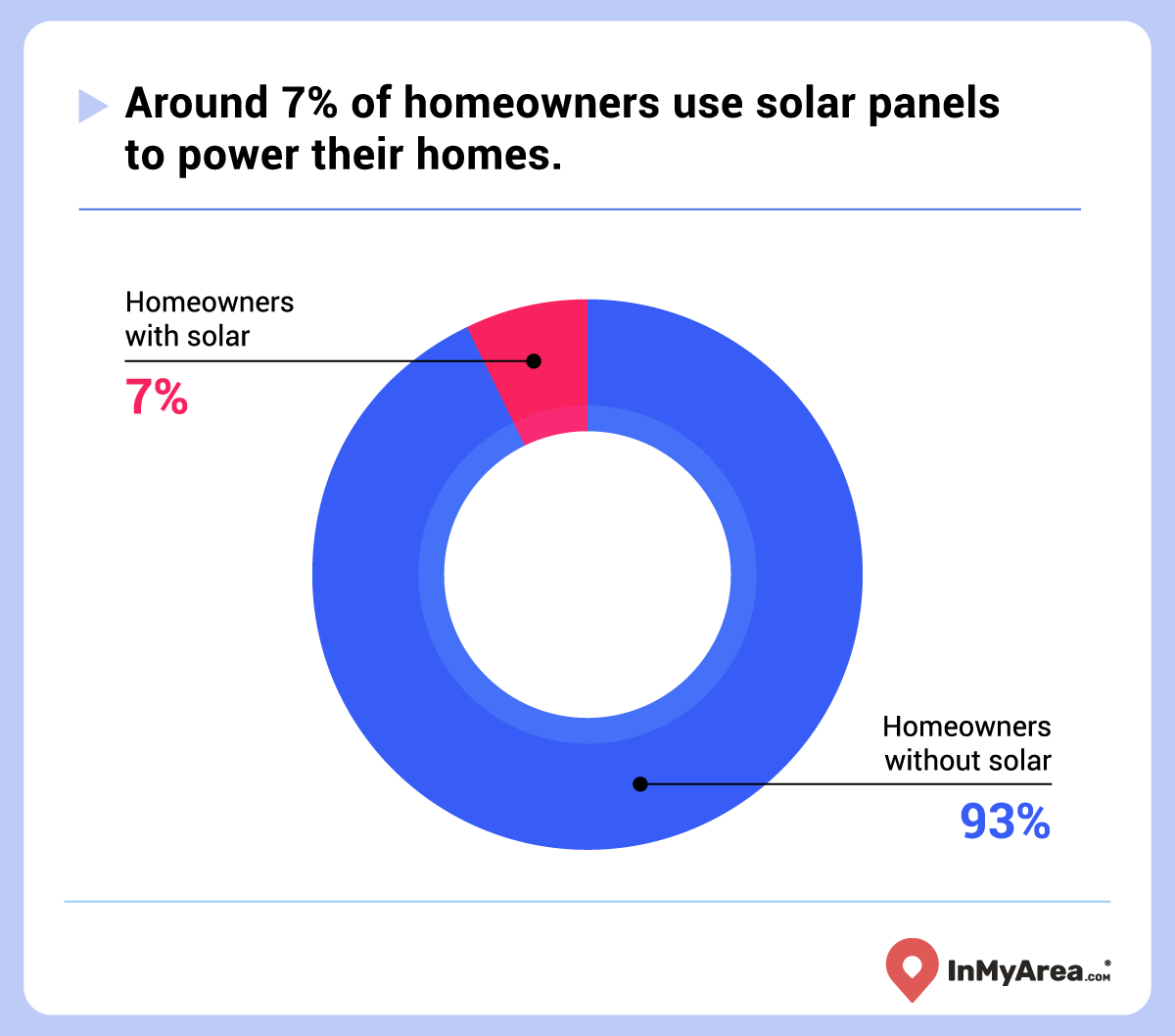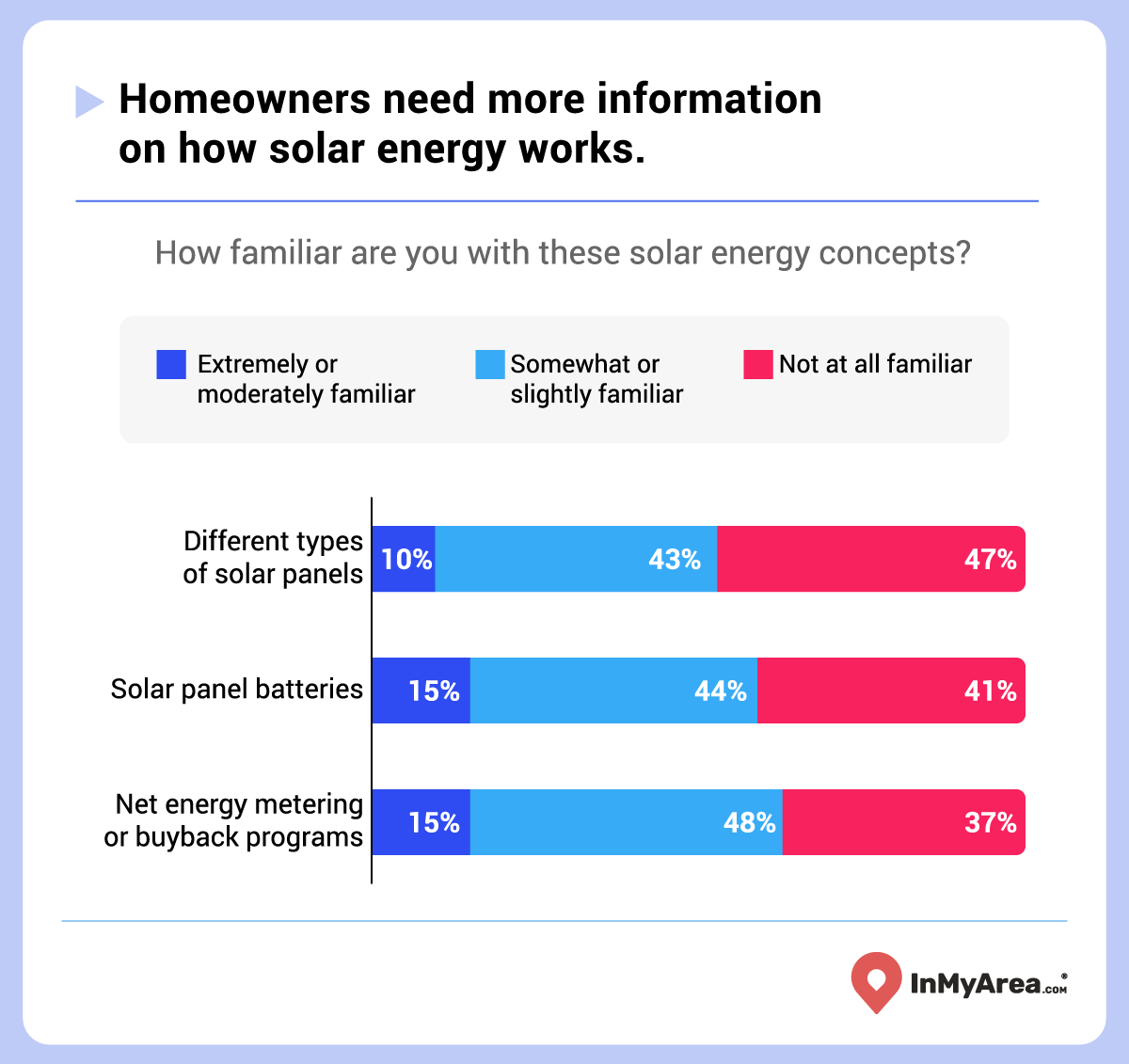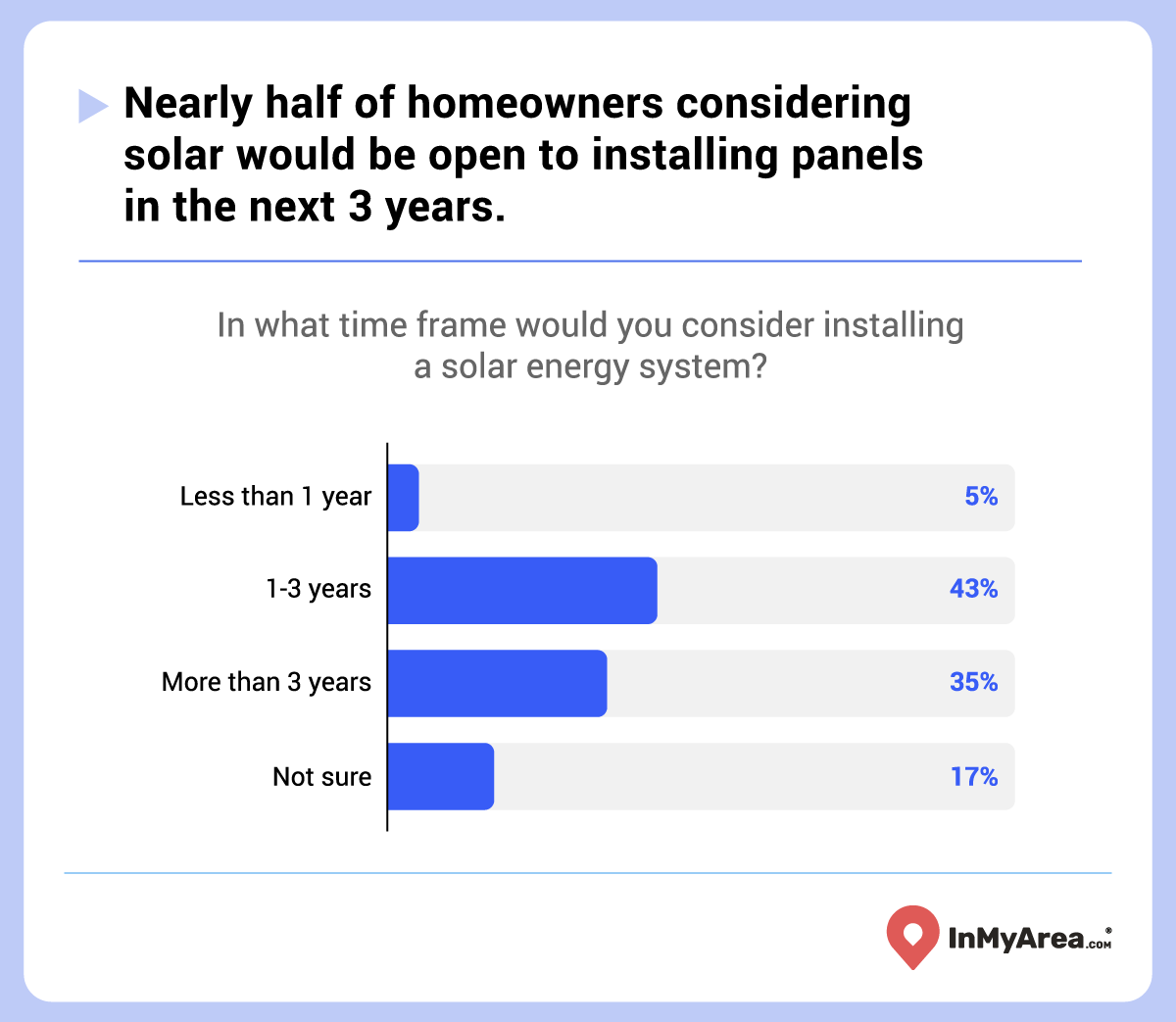These days, energy issues dominate headlines, and Americans are understandably concerned about power grid insecurities, rising energy costs, and climate change. As a result, they’re increasingly interested in how renewable energy sources, like solar, could help solve these pressing issues.
However, misinformation, evolving technology, and financial concerns deter many homeowners from harnessing solar energy. To accelerate rooftop solar adoption, the industry must understand the underlying attitudes, anxieties, and motivations driving this shift.
Considering this, we gathered extensive insights from more than 2,800 homeowners in the United States. Our goal was to better understand the average person's thoughts on the future of solar energy. The results of this research have uncovered essential trends and strategies, and those interested in expanding the use of solar energy should pay close attention."
Key Findings
- As many as 4 million American households currently have solar panel systems, and most solar users in our study were highly satisfied.
- Nearly half of eligible homeowners who were open to installing solar panels said their time frame for adoption would be within the next three years. This means an estimated 16 million households could install solar in the near future.
- Notably, the upfront cost is the most significant deterrent to installing solar, but many people don’t understand the actual price for installation. Our respondents estimated solar installation could cost anywhere from $0 to $125,000, but the average cost today is actually around $25,000 before incentives or tax credits.
- About a quarter of homeowners without solar said weather damage was a primary concern when considering solar installations. In reality, solar panels are designed to withstand high winds, rains, and extreme temperatures, and like the rest of the home, damages to panels can be covered by homeowners insurance.
- Power reliability was a key barrier to adoption for 23 percent of homeowners without solar panels. However, solar panels increase energy access and diversify the sources of energy powering homes.
Table of Contents
- Solar Panel Adoption Rates and Attitudes
- Top Barriers to Residential Solar Panel Installations
- Overcoming Solar Cost Barriers
- What Can Potential Customers Learn From Current Solar Users?
- Market Outlook for Residential Solar Panels
Solar Panel Adoption Rates and Attitudes
According to our study, approximately 7 percent of homeowners have solar panels. Extrapolating this percentage to the entire U.S. population could amount to 4 million American households. Our findings align with recent Pew Research Center figures, which reported that eight percent of U.S. homes had solar installations.

While houses with solar remain a minority in the U.S., it's crucial to emphasize the remarkable growth rate in this sector. The Solar Energy Industries Association (SEIA), which represents the U.S. solar installation industry, reported an impressive average annual growth rate of 24 percent over the past decade. To put this into perspective, the number of small-scale residential solar installations increased eightfold, from 3.3 gigawatts (GW) in 2014 to 26.3 GW in 2022. This incredible growth came after solar energy in the U.S. was initially considered more of a novelty or a minor player in the energy landscape until recent years.
At the same time, the Inflation Reduction Actis sparking an unprecedented surge in solar panel production within the country to meet the rising demand. In 2022, the Energy Information Administration recordedan all-time high in the shipment of solar panels to the U.S. The expansion of solar installations is just getting started.
While the growth hasn’t been explosive, it has been steady. Some of the most critical progress involves homeowner attitudes. According to our research, 86 percent of households would possibly consider solar panels for their home, with 43 percent reporting that they would definitely consider them.
Would you consider installing solar | Percentage of homeowners without solar |
|---|---|
Definitely consider | 43% |
Might or might not consider | 43% |
Would not consider | 14% |
As with most topics today, though, variation persists in how different population segments feel about solar. Some groups were far more likely to consider solar than others. Of note, we found that:
- Male homeowners were likelier than female homeowners to ‘definitely’ consider installing solar.
- Liberal-leaning Americans were more likely to consider solar than their conservative counterparts, while conservatives were more likely to respond that they definitely would not consider solar.
- Younger homeowners (i.e., up to 30 years old) were much more open to installing solar on their rooftops than more mature homeowners (i.e., older than 60 years old).
Beyond demographic variations, a significant pattern emerged from the data, conveying a clear message: respondents who perceived their electricity bills as "unreasonable" were more inclined to seriously consider solar panels than those who believed their energy bills were manageable. This underscores that solar panels effectively lower monthly energy expenses, despite the initial upfront costs, and resonates with individuals striving to reduce utility bills.
Level of openness to solar installation, by attitude toward current energy bills
Would you consider installing | My energy bills are totally | My energy bills are just right | My energy bills are very |
|---|---|---|---|
Definitely consider | 48% | 41% | 32% |
Might or might not consider | 40% | 45% | 45% |
Would not consider | 12% | 14% | 24% |
It's worth noting that 45 percent of homeowners had researched solar panels within the past two years. However, this research was often limited to gathering general information about solar energy rather than delving into specific vendors and technologies or obtaining personalized quotes. Only 19 percent of those who’d recently engaged in solar research intended to make an actual purchase.
Nevertheless, the fact that many homeowners are open to conducting their own research indicates the progress made by the solar industry and the potential impact of guiding these "solar-curious" individuals. Offering them authoritative, trustworthy, and actionable information could be instrumental in converting them into solar adopters.
People who researched solar mainly relied on online sources like price comparisons, online reviews, YouTube videos, and solar-related websites. Since a minority of homes have solar installed, not everyone has a trusted friend or family member who can answer their questions about solar. Accordingly, quality online resources are essential for today’s solar shoppers.

While it's encouraging that so many homeowners have sought out solar energy information, our research revealed that key knowledge gaps remain. Many homeowners have seen solar panels on rooftops and know they generate power. Still, they may not be well-versed in the various types of solar panels, batteries, and financial resources available for installing solar systems. Only 10 to 15 percent of homeowners in our study felt very familiar with solar panel batteries and net energy metering programs. In contrast, 37 to 47 percent of respondents were not at all familiar with these specific aspects of solar energy.

What do these results tell us? Generally, most people don’t have a solid understanding of solar energy and solar systems. Without that understanding, misinformation is more likely to have an impact. This lack of knowledge about solar’s benefits could hold back potential adopters who would have otherwise taken the leap.
That said, do people need to be experts in solar panel technology to adopt them? For instance, most people don't understand how their car engines work, but still drive cars. Similarly, the general public doesn't need an in-depth understanding of solar science. What matters is trust in the equipment's reliability and confidence in the benefits, including financial gains. Educating homeowners about pairing batteries with solar panels can help maximize these benefits.
Unlike cars and air conditioners, which have always been part of our modern lives, solar panels are relatively new to many homeowners, especially older generations. This novelty can lead to skepticism. Solar companies must tailor their approach to different potential adopter groups to overcome these barriers.
Top Barriers to Residential Solar Panel Installations
Solar energy and the installation of solar panels are rapidly becoming popular. However, many eligible homeowners remain hesitant. We asked respondents to share their primary concerns about installing solar panels:
What are your greatest concerns about installing | Percent of homeowners without solar |
|---|---|
Cost | 74% |
Equipment maintenance | 30% |
Panel damage from weather (hail, hurricane) | 26% |
Reliability | 23% |
Pushy salespeople | 17% |
Panel efficiency | 16% |
My house isn’t suited to solar | 16% |
The appearance or aesthetics of solar panels | 13% |
Local permits or HOA policies | 12% |
Battery storage | 11% |
Buyback or net metering plans | 10% |
Not enough information about how solar works | 9% |
Customer support | 3% |
Impact on other energy jobs (coal, gas, etc.) | 1% |
I have no concerns | 1% |
Let’s dig into Americans’ top solar concerns to see which reflect real issues and which could be overcome with additional education.
Cost
The cost of installing solar panels was far and away the most commonly cited hesitation. Nearly three-quarters of respondents listed cost as one of their top three concerns. Price concerns are becoming even more significant due to recent headlines that reveal supply chain disruptions have caused an increase in solar panel costs. Additionally, comprehending the local tax implications and benefits for customers who are not industry experts can take time and effort.
As mentioned earlier, it's important to note that some concerns about high prices are based on misconceptions. Our survey respondents, for instance, estimated solar panel installation costs could reach as high as $120,000. However, the actual average price, before accounting for tax incentives, is approximately $25,000.
While the initial upfront costs are just one part of the equation, it's essential to consider the long-term benefits. Solar panels typically have a lifespan of 20-30 years after installation, and industry studies indicate solar installations can recoup their costs within just 5-10 years. The actual value emerges in reduced utility bills and, in some cases, even potential profits through net metering. This is where you sell excess energy back to your utility provider. Solar panels generally increase home sale prices by 4 percent, according to a Zillow analysis.
Every homeowner should perform their own calculations to understand what their payback period might look like. In almost all scenarios, the payback period will be shorter than the expected life span of the solar panels. This means homeowners will effectively have free energy for the remainder of the solar panel's lifetime.
Furthermore, this advantage is likely to increase in value over time. Utility electric rates tend to fluctuate and have risen in recent years. Consequently, the electricity generated from rooftop solar power becomes even more valuable as it shields homeowners from these increasing costs.
2. Maintenance
The second most common concern regarding solar panels was maintenance. This highlights a challenge for the solar industry because this concern can be an exaggerated barrier. In reality, homeowners who install solar panels on their rooftops typically don't need to worry about frequent maintenance tasks, like climbing onto the roof for cleaning.
Most solar panel instruction manuals recommend a light cleaning twice yearly, which can be accomplished by hand. For the DIY homeowner who hangs holiday lights on the house or cleans the gutters, cleaning the solar panels would be a simple task. However, even those who want to avoid climbing onto the roof can have their panels cleaned at the same time they’re inspected. Much like other appliances, such as air conditioners, solar systems should be inspected annually to ensure the equipment is running optimally.
3. Weather damage
For about a quarter of the respondents, weather damage was a key concern regarding solar panels. In most cases, though, solar panels are not more susceptible to weather-related damage than other parts of the house. There have even been instances where solar panels continued to generate power during hailstorms!
In fact, solar panels are designed to withstand common weather conditions, including high winds, snow, extreme temperatures, and rain. They are generally very resilient. Of course, extreme weather events, like major hailstorms or direct-hit hurricanes, can pose a risk, but these situations are exceptional. In these cases, the entire dwelling would be severely damaged.
Homeowners interested in solar panels should speak with an insurance agent before installation to ensure they can be covered by their homeowners' insurance. Generally, solar panels can be insured under the main homeowners' policy, and this type of coverage helps protect against any potential damage caused by severe weather.
4. Reliability
According to our research, the reliability of solar panels was a major concern for homeowners. In reality, solar panels actually make power access more reliable since it diversifies the energy sources available. Typically, when households install solar panels, the solar power generation is a supplement to electricity coming from the grid. Generally, solar energy would not totally replace electricity from the grid. At night, or during cloudy weather, homeowners can still source power from the grid as they normally would.
During grid outages, most homes with solar panels will still have power. Those without solar panels have no option but to wait for the electric power to return. Further, homes with solar panels and energy storage systems have even more dependable power. They would be able to generate and store up energy while the sun shines, which could be used at night, in cloudy weather, or power outages.
5. Pushy salespeople
Interestingly, pushy salespeople rounded out the top concerns homeowners had about solar panels. Dealing with salespeople who were aggressive or dishonest discouraged them from considering solar panel installation. Approximately 1 in 5 respondents reported speaking with a solar representative, and the concern about pushy salespeople was more common among female respondents than males.
The popularity of this response underscores a crucial aspect for solar companies to consider in their approach. However, it may be one of the easier barriers to overcome. While some customers may have had negative experiences leading to mistrust, better-trained salespeople who provide reliable and helpful information, and respect a customer's decision when it's a "no," can help potential adopters feel more comfortable with solar.
To boost the industry, it's essential for solar companies to offer safe, reliable, and trustworthy resources for customers to learn independently and to help them identify and avoid potentially unethical companies or scams. Many major solar companies already offer self-service options on their websites and allow customers to schedule appointments independently — without being bombarded by solicitors.
Overcoming Solar Cost Barriers
A major theme in our research is that the cost of solar panel installation is a significant barrier to adoption for many homeowners.
Compared with other concerns like home suitability, appearance, and lack of knowledge, cost was the most difficult barrier for homeowners to overcome. To encourage greater adoption of solar energy, the most significant opportunities lie in lowering installation costs or, at the very least, educating customers about the fact that the costs may not be as intimidating as they might believe.

Among people searching for solar information online, the most frequent search terms they utilized involved the value and overall cost of solar panels and installation. While there’s no doubt there are environmental- and technology-driven adopters, people want to predict their out-of-pocket costs and estimates of the potential savings they can expect before they move toward installation. However, because of the variation in solar companies, regional tax incentives, and the amount of power various houses can generate, it can be difficult to accurately predict the ROI on solar systems before they’re installed.
As noted above, the average cost to install solar on a U.S. home is around $25,000, though the out-of-pocket cost can be much lower. Today, the U.S. government is offering homeowners who install solar panels a tax credit worth 30 percent of the installation cost (for a $25,000 installation, the government would give a tax credit of about $7,500). Of course, that cost may still be too high for many households to invest all at once. In such cases, homeowners still have additional options to save:
- Identify local and state rebates and incentives for installing rooftop solar, which can be done by searching for their jurisdiction on the Database of State Incentives for Renewable & Efficiency(DSIRE).
- See if they qualify for financial assistance programs, such as the Energy Efficient Mortgage program from the U.S. Department of Energy.
- Find providers or local organizations that can set up your household with Tariff On-Bill Financing TOBF) for solar installations, which covers the upfront costs and pays for them via a portion of the monthly utility bill savings.
- Shop around different solar installers to find the best rates and identify which may have partnerships and opportunities for financing that work best for their individual situation.
- Leasing solar panels can potentially reduce consumers’ costs (though only 51 percent of respondents were aware of this option). Leasing can come with risks that must be weighed by the homeowner. (The U.S. Environmental Protection Agency cites the more complex negotiations, administrative costs, property tax impacts, and others.)
Overall, the availability of financing programs could improve interest, even among those who are currently not at all open to solar panels presently:
What cost-reduction options would make you more | Percent of homeowners not considering solar |
|---|---|
Lower initial cost | 73% |
Government loan or subsidy | 66% |
Financing options | 34% |
Leasing solar panels | 18% |
None of the above | 9% |
What Can Potential Customers Learn From Current Solar Users?
In our research, we gathered insights not only from those considering or rejecting solar installations but also from those who already had solar panels on their homes. Among current solar users, 1 in 5 had solar panels in place when they moved into their current homes, while the remaining 4 out of 5 installed the panels themselves. Notably, in both of these groups, over half of the solar panel users expressed either extreme or high satisfaction with their solar systems!
Top Pros and Cons of Residential Solar, According to Current Users
What do you like the MOST about your solar energy system? | What do you like LEAST about your solar energy system? |
|---|---|
1.Cost savings:Many noted reduced electric bills and overall savings as their favorite aspect of having a solar energy system. This includes both immediate monthly savings and long-term reductions in energy costs. | 1.Affordability: Users expressed disappointment with the high costs associated with solar energy, covering aspects from initial installation cost and cost of potential batteries for energy storage, to monthly lease payments and overall upkeep. |
2.Renewable and environmentally-friendly energy: Several people mentioned they loved that their solar energy systems produced renewable, clean energy. | 2.Performance and energy generation: The respondents indicated dissatisfaction with the amount of energy their solar panels generated, especially during winter and when attempting to power high-energy devices. |
3.Energy independence: Some valued their systems’ ability to generate more power than they use, the ability to return excess power to the grid, and not having to rely on local power companies. | 3.Dependency on the electricity grid: Several solar users mentioned discontentment with the lack of battery storage and consequent dependency on the electricity grid when solar panels weren't generating power, such as at night or during blackouts. |
4.System efficiency and little maintenance: Users mentioned that solar panels operated smoothly, without requiring intense thought or extensive maintenance. | 4.Maintenance: Some voiced concerns over maintaining their solar energy systems in the long term. They mentioned the difficulty of keeping solar panels clean and the potential for needing to replace parts. Others felt unprepared for the eventual work needed on their roofs due to the presence of panels. |
5.Long-term financial benefits: Some respondents emphasized a return on investment over time, the capability of the panels to generate more electricity than is used in the household, and even earning a credit or receiving money back. | 5.Engagement with solar energy companies: Some owners had issues with the companies they bought or leased their solar panel systems from, citing problems with contracts, disagreements over sell-back prices, and disappointments with customer service. |
As detailed above, current solar owners reported both pros and cons, so evaluating those responses can be quite useful for those who are still in the consideration stage. Overall, many of the benefits and risks of installation for users came down to money. The most popular benefit was cost savings, while the most prevalent frustration was the high upfront costs. Balancing these two factors remains the top requirement of solar installers and their customers moving ahead.
Additionally, many people reported they loved having energy independence and controlling their power usage. However, they became frustrated when they still had to rely on the traditional grid. This shows that solar installers need to manage expectations better. Solar is meant to complement your energy needs, but if you expect to completely replace your utility company, you'll likely be disappointed.
Market Outlook for Residential Solar Panels
Despite the barriers to adoption we’ve detailed, the market outlook for residential solar remains as strong as ever. Our study discovered that 86 percent of eligible homeowners without solar were open to considering it, and only 14 percent of nonusers were not open to solar.
Among those who were open to solar panels, we asked about their time frame for adoption. While 5 percent said it would be within the next year, most needed more time to review their options. Forty-three percent said they’d consider installation between one and three years from now.

When it comes to buying homes with solar panels already installed, many people in our study saw this as a big advantage. In the study, 63 percent of respondents said they'd be very interested in buying a home with pre-installed solar panels. These numbers show that there's a lot of interest in solar panels, and the main concerns seem to be related to the process of installing them, not their ongoing use and maintenance.
With these factors in mind, we can expect the solar market to grow significantly in the coming years. This growth will be driven by advanced technologies, increased clean energy goals, and more readily available supply chains. It will also depend on homeowners having access to clear information about the upfront and ongoing costs of solar, as well as potential savings through financial assistance programs.
Conclusion
The transition to solar energy in residential areas is on an upward trajectory, marked by increasing interest and a growing understanding of its long-term benefits. However, as our comprehensive research illustrates, there are still significant barriers to adoption, with cost considerations at the forefront. To navigate these concerns, it's vital for potential adopters to arm themselves with accurate and up-to-date information. At the same time, solar installers must understand the worries and even misinformation customers are dealing with.
For those considering the leap to solar, information on local incentives and rebates can be found at your local utility and government offices. Additionally, discussions with established solar homeowners and consultations with reputable solar companies can dispel myths and clarify the true costs and benefits of solar installation. The future shines bright for solar energy; it's just a matter of bridging the knowledge gap and empowering homeowners to make informed decisions.
Our data
In July and August 2023, we conducted a two-phase internet-based poll. In total, the studies included 1,365 American adults aged 18 or older. Respondents had to be homeowners living in detached, single-family homes to qualify for participation. They had to be the primary financial decision-makers in the home or share financial decision-making responsibilities with others in the home. All respondents had household incomes of at least $50,000 after tax. Participation was limited to residents of the following states: AZ, AK, CA, FL, GA, IL, IA, KS, LA, MO, NE, NV, NM, OH, OK, SC, TN, TX, and VA. Our report also included selected statistics from another 2023 poll of 1,501 respondents conducted by the Olinger Group and provided by ADT Solar.


